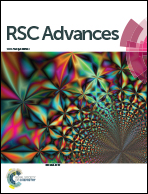Performance and characterization of a non-sintered zeolite porous filter for the simultaneous removal of nitrogen and phosphorus in a biological aerated filter (BAF)†
Abstract
A novel non-sintered zeolite porous filter (ZPF) and commercially available ceramsite (CAC) are used to investigate the simultaneous removal of nitrogen and phosphorus from city wastewater treated by biological aerated filter (BAF) reactors. The chemical and physical characteristics of ZPF and CAC are measured. ZPF has a higher porosity and larger total surface area than CAC. In addition, the interconnected porous structure obtained for ZPF is suitable for microbial biofilm growth. In the present study, the influence of the hydraulic retention time on the removal of phosphorus (PO43−), total nitrogen (TN), ammonia nitrogen (NH3–N), and total organic carbon (TOC) are studied. The results show that the ZPF BAF performs much better than the CAC BAF. Microbial biofilm morphology also shows that more microorganisms are loaded in the ZPF BAF. The polymerase chain reaction and denaturing gradient gel electrophoresis and sequence analysis of 16S RNA gene fragments show that Comamonas testosteroni, uncultured Comamonas sp., and uncultured Nitrospira sp. are primarily detected in the ZPF BAF and this attached growth benefits the simultaneous nitrification and denitrification performance of the ZPF BAF. Thus, ZPF has potential use as novel material for the simultaneous removal of nitrogen and phosphorus of BAF in wastewater treatment.


 Please wait while we load your content...
Please wait while we load your content...